TOYOTA YARIS 2015 3.G Owners Manual
Manufacturer: TOYOTA, Model Year: 2015, Model line: YARIS, Model: TOYOTA YARIS 2015 3.GPages: 364, PDF Size: 5.74 MB
Page 91 of 364
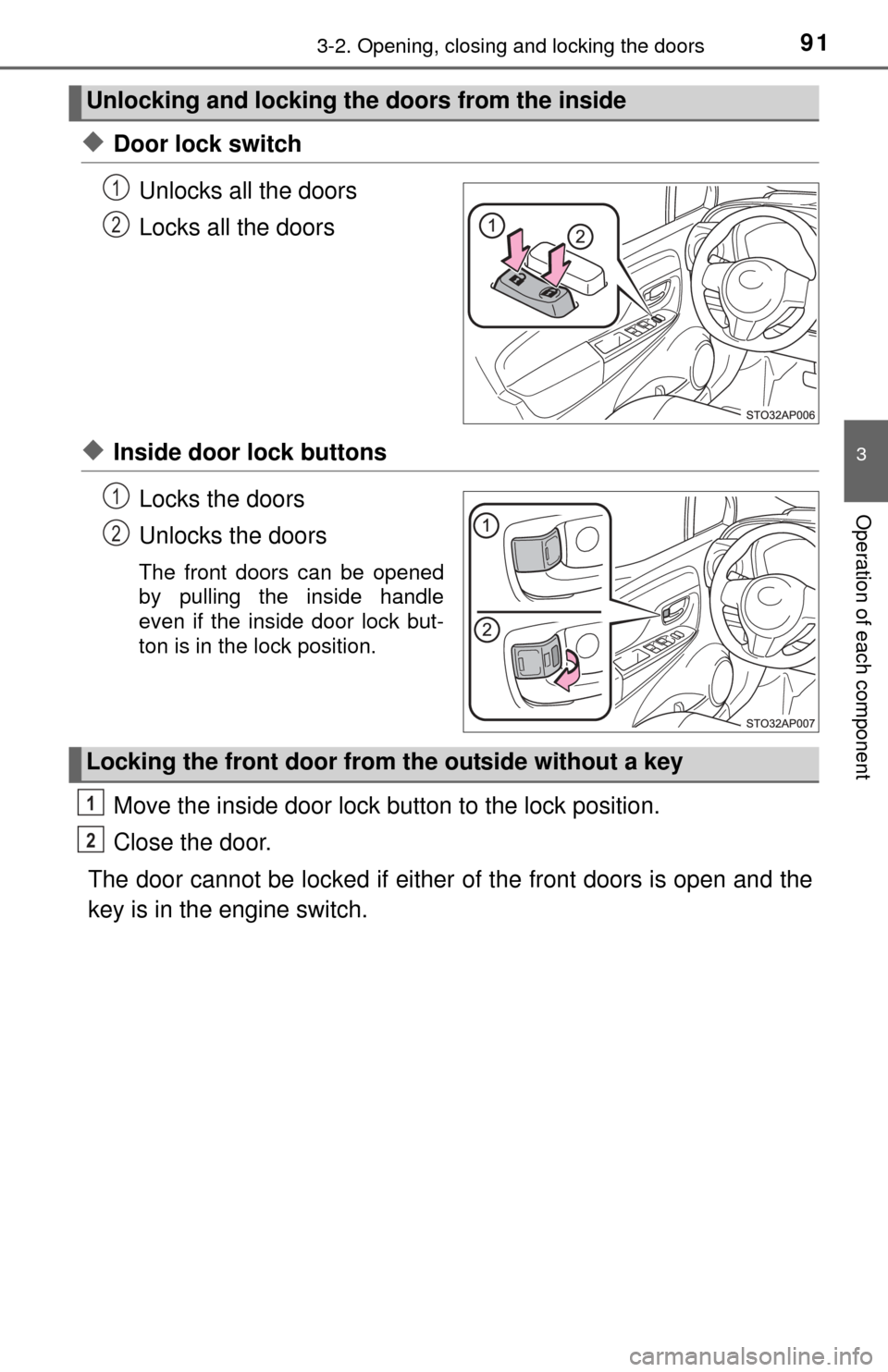
913-2. Opening, closing and locking the doors
3
Operation of each component
◆Door lock switchUnlocks all the doors
Locks all the doors
◆Inside door lock buttonsLocks the doors
Unlocks the doors
The front doors can be opened
by pulling the inside handle
even if the inside door lock but-
ton is in the lock position.
Move the inside door lock button to the lock position.
Close the door.
The door cannot be locked if either of the front doors is open and the
key is in the engine switch.
Unlocking and locking the doors from the inside
1
2
1
2
Locking the front door from the outside without a key
1
2
Page 92 of 364
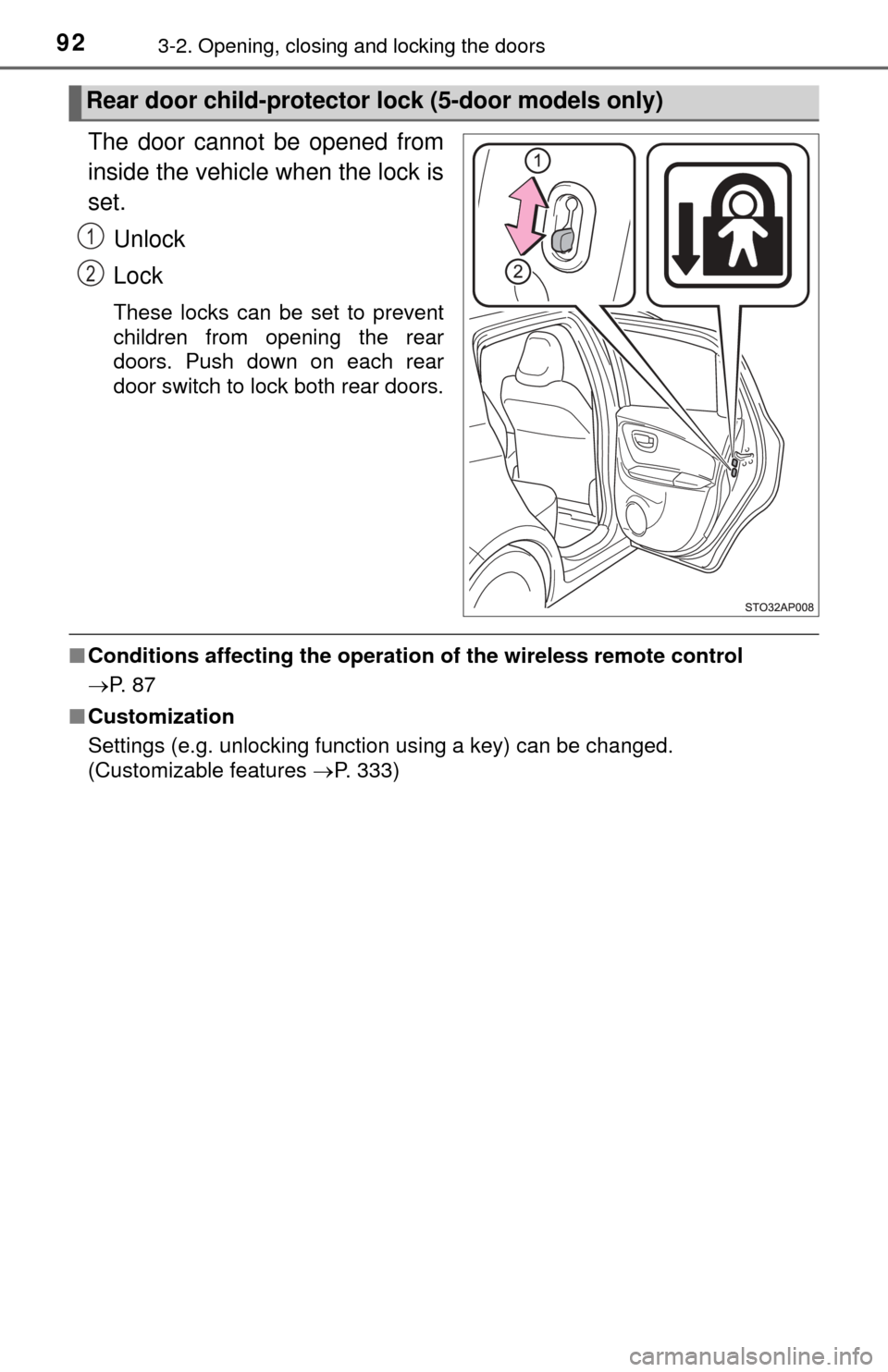
923-2. Opening, closing and locking the doors
The door cannot be opened from
inside the vehicle when the lock is
set.Unlock
Lock
These locks can be set to prevent
children from opening the rear
doors. Push down on each rear
door switch to lock both rear doors.
■Conditions affecting the operatio n of the wireless remote control
P. 8 7
■ Customization
Settings (e.g. unlocking function using a key) can be changed.
(Customizable features P. 333)
Rear door child-protector lock (5-door models only)
1
2
Page 93 of 364

933-2. Opening, closing and locking the doors
3
Operation of each component
WARNING
■To prevent an accident
Observe the following precautions while driving the vehicle.
Failure to do so may result in a door opening and an occupant falling out,
resulting in death or serious injury.
● Always use a seat belt.
● Always lock all the doors.
● Ensure that all the doors are properly closed.
● Do not pull the inside handle of the doors while driving.
The doors may be opened and the passengers are thrown out of the vehi-
cle and it may result in serious injury or death.
Be especially careful for the front doors, as the doors may be opened
even if the inside lock buttons are in locked position.
● Set the rear door child-protector locks when children are seated in the rear
seats.
Page 94 of 364
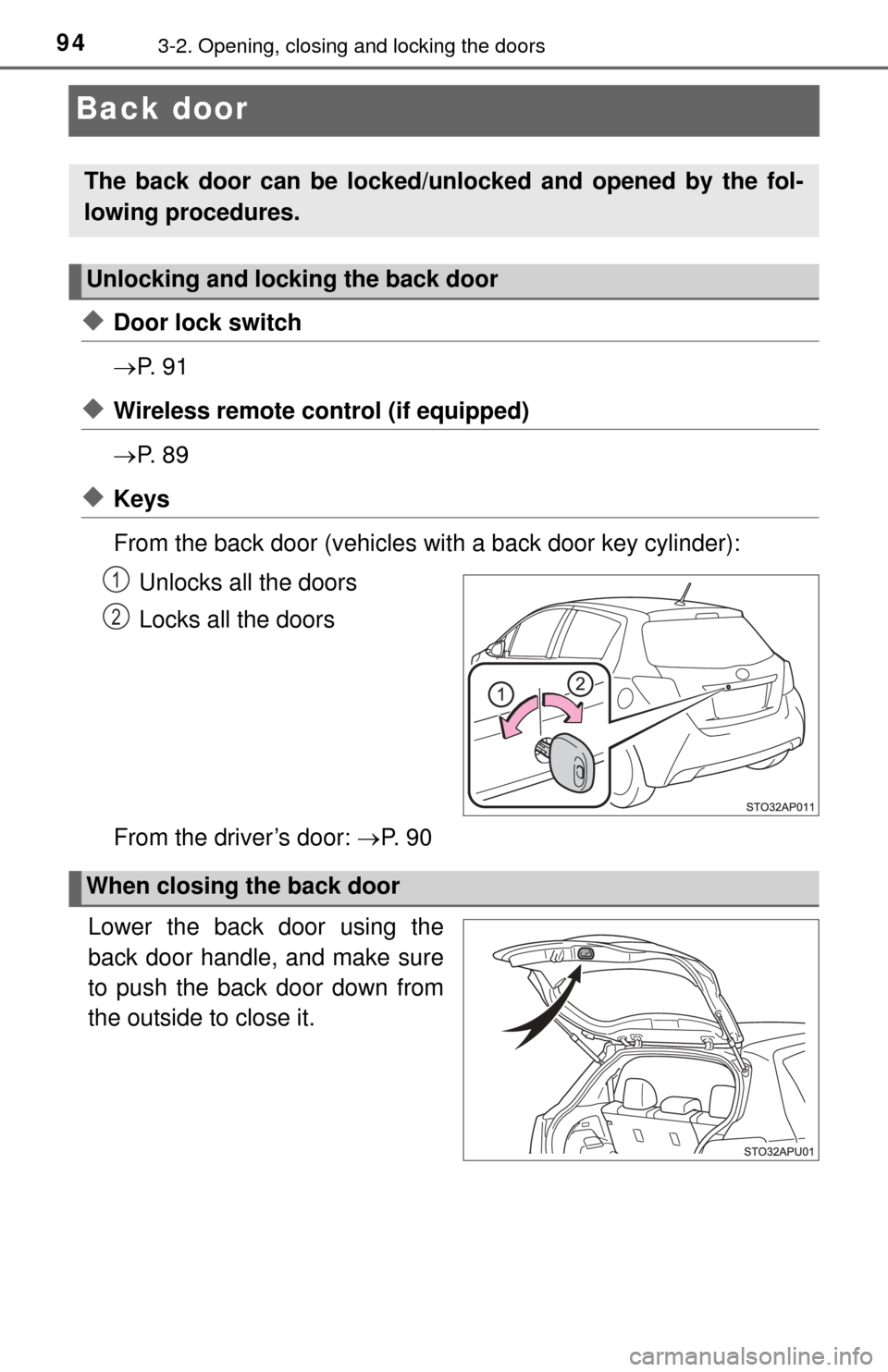
943-2. Opening, closing and locking the doors
Back door
◆Door lock switch
P. 9 1
◆Wireless remote control (if equipped)
P. 8 9
◆Keys
From the back door (vehicles with a back door key cylinder):
Unlocks all the doors
Locks all the doors
From the driver’s door: P. 9 0
Lower the back door using the
back door handle, and make sure
to push the back door down from
the outside to close it.
The back door can be locked/unl ocked and opened by the fol-
lowing procedures.
Unlocking and locking the back door
1
2
When closing the back door
Page 95 of 364

953-2. Opening, closing and locking the doors
3
Operation of each component
■Operation signals (vehicles with a wireless remote control)
P. 9 0
■ Security feature (vehicles with a wireless remote control)
P. 9 0
■ Luggage compartment light
The luggage compartment lights turn on when the back door is opened.
WARNING
Observe the following precautions.
Failure to do so may result in death or serious injury.
■Before driving
● Make sure that the back door is fully closed. If the back door is not fully
closed, it may open unexpectedly while driving and hit near-by objects or
luggage in the luggage compartment may be thrown out, causing an acci-
dent.
● Do not allow children to play in the luggage compartment.
If a child is accidentally locked in the luggage compartment, they could
have heat exhaustion or other injuries.
● Do not allow a child to open or close the back door.
Doing so may cause the back door to open unexpectedly, or cause the
child’s hands, head, or neck to be caught by the closing back door.
■ Important points while driving
● Keep the back door closed while driving.
If the back door is left open, it may hit near-by objects or luggage in the
luggage compartment may be thrown out, causing an accident.
● Never let anyone sit in the luggage compartment. In the event of sudden
braking or a collision, they are susceptible to death or serious injury.
Page 96 of 364
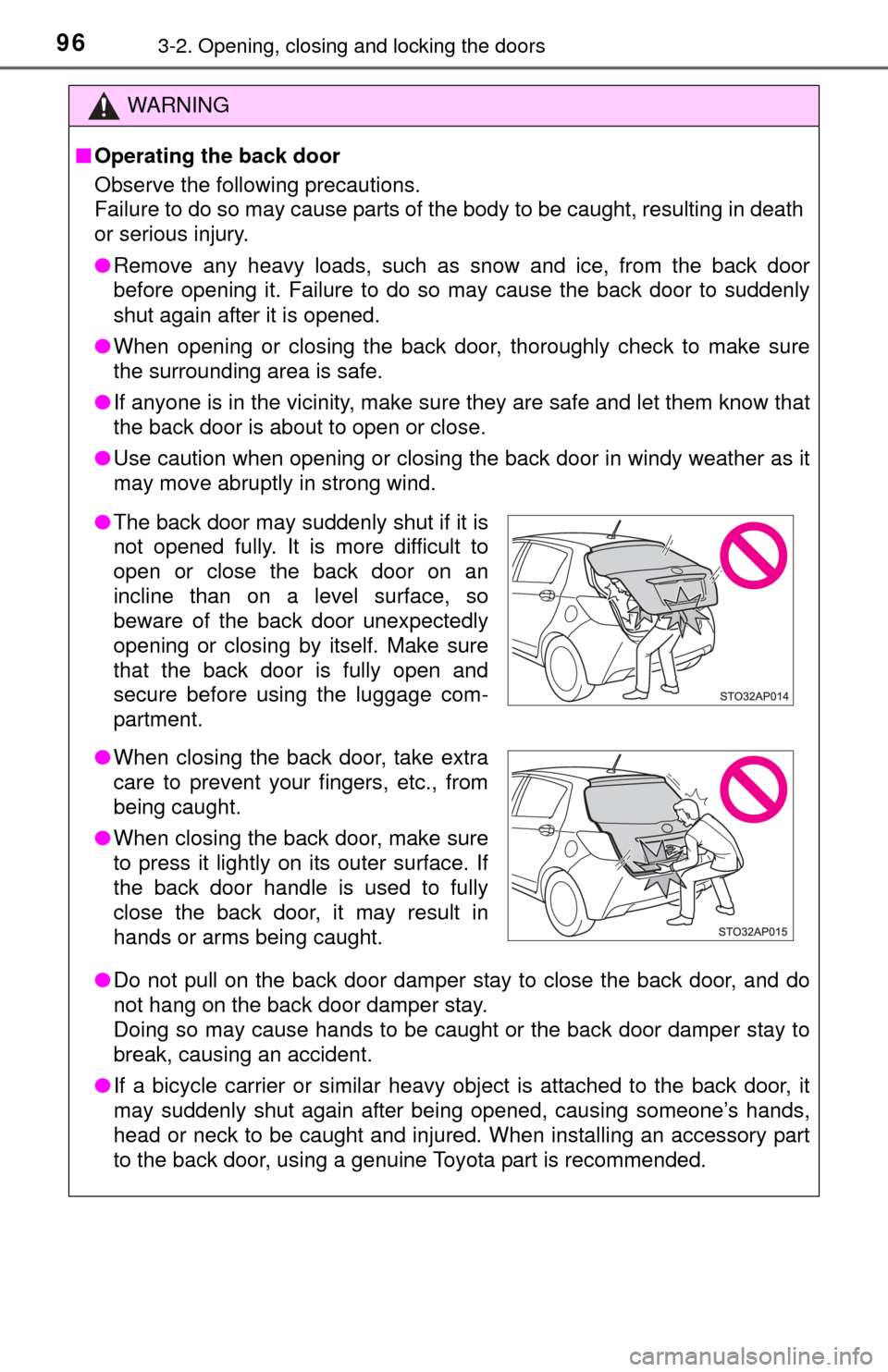
963-2. Opening, closing and locking the doors
WARNING
■Operating the back door
Observe the following precautions.
Failure to do so may cause parts of the body to be caught, resulting in death
or serious injury.
● Remove any heavy loads, such as snow and ice, from the back door
before opening it. Failure to do so may cause the back door to suddenly
shut again after it is opened.
● When opening or closing the back door, thoroughly check to make sure
the surrounding area is safe.
● If anyone is in the vicinity, make sure they are safe and let them know that
the back door is about to open or close.
● Use caution when opening or closing the back door in windy weather as it
may move abruptly in strong wind.
● Do not pull on the back door damper stay to close the back door, and do
not hang on the back door damper stay.
Doing so may cause hands to be caught or the back door damper stay to
break, causing an accident.
● If a bicycle carrier or similar heavy object is attached to the back door, it
may suddenly shut again after being opened, causing someone’s hands,
head or neck to be caught and injured. When installing an accessory part
to the back door, using a genuine Toyota part is recommended.
●The back door may suddenly shut if it is
not opened fully. It is more difficult to
open or close the back door on an
incline than on a level surface, so
beware of the back door unexpectedly
opening or closing by itself. Make sure
that the back door is fully open and
secure before using the luggage com-
partment.
● When closing the back door, take extra
care to prevent your fingers, etc., from
being caught.
● When closing the back door, make sure
to press it lightly on its outer surface. If
the back door handle is used to fully
close the back door, it may result in
hands or arms being caught.
Page 97 of 364
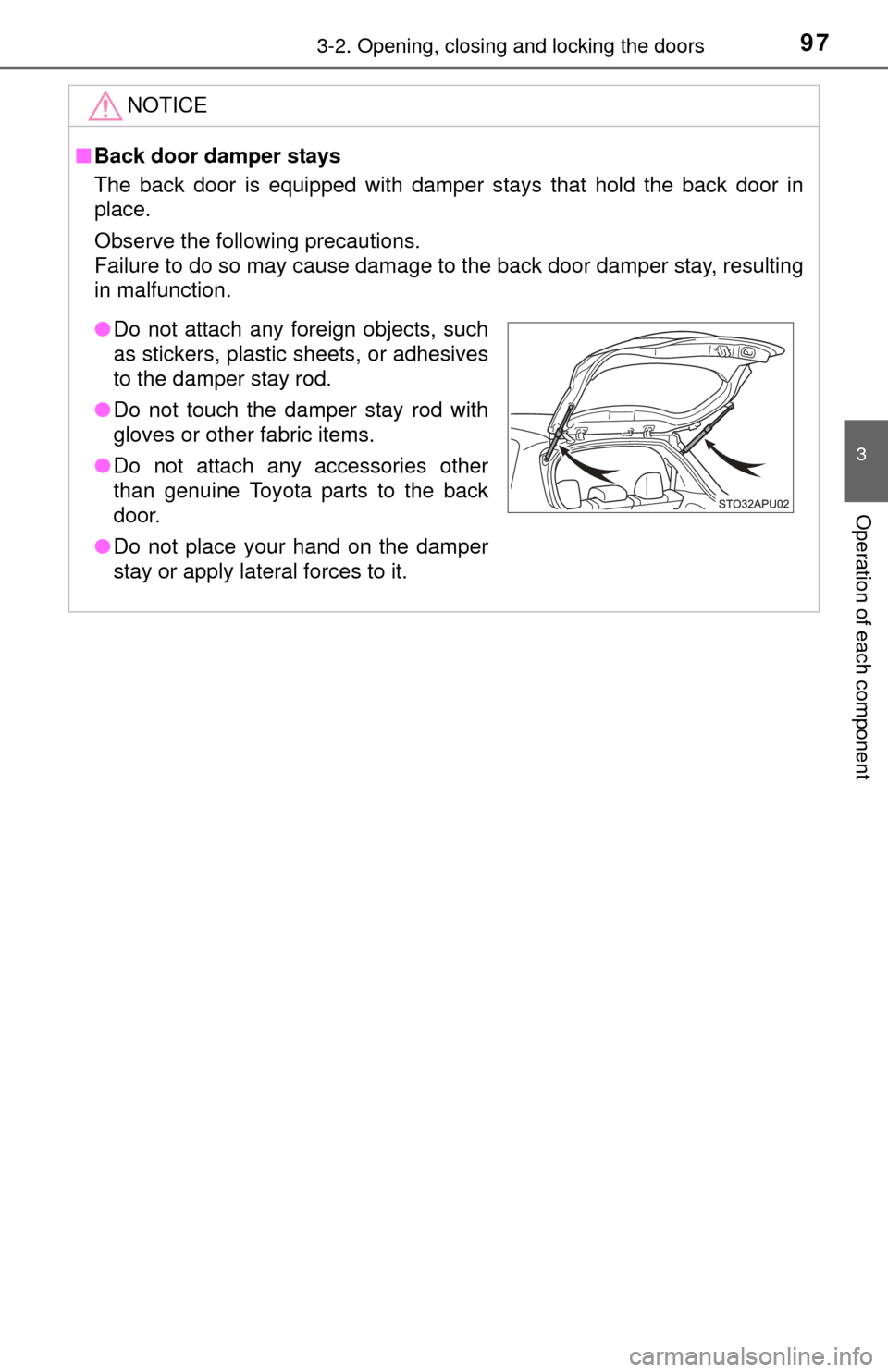
973-2. Opening, closing and locking the doors
3
Operation of each component
NOTICE
■Back door damper stays
The back door is equipped with damper stays that hold the back door in
place.
Observe the following precautions.
Failure to do so may cause damage to the back door damper stay, resulting
in malfunction.
● Do not attach any foreign objects, such
as stickers, plastic sheets, or adhesives
to the damper stay rod.
● Do not touch the damper stay rod with
gloves or other fabric items.
● Do not attach any accessories other
than genuine Toyota parts to the back
door.
● Do not place your hand on the damper
stay or apply lateral forces to it.
Page 98 of 364
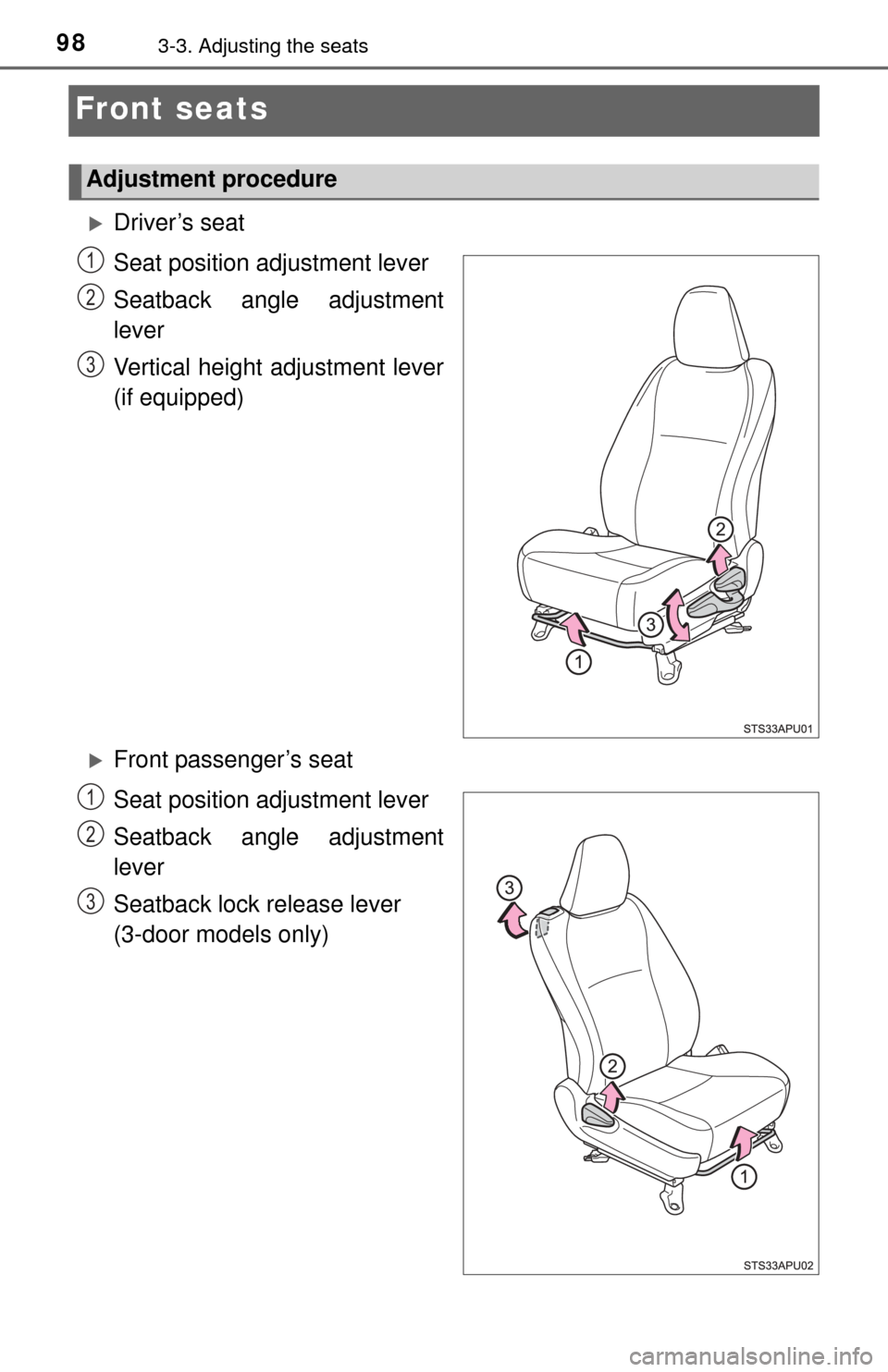
983-3. Adjusting the seats
Front seats
Driver’s seat
Seat position adjustment lever
Seatback angle adjustment
lever
Vertical height adjustment lever
(if equipped)
Front passenger’s seat
Seat position ad justment lever
Seatback angle adjustment
lever
Seatback lock release lever
(3-door models only)
Adjustment procedure
1
2
3
1
2
3
Page 99 of 364
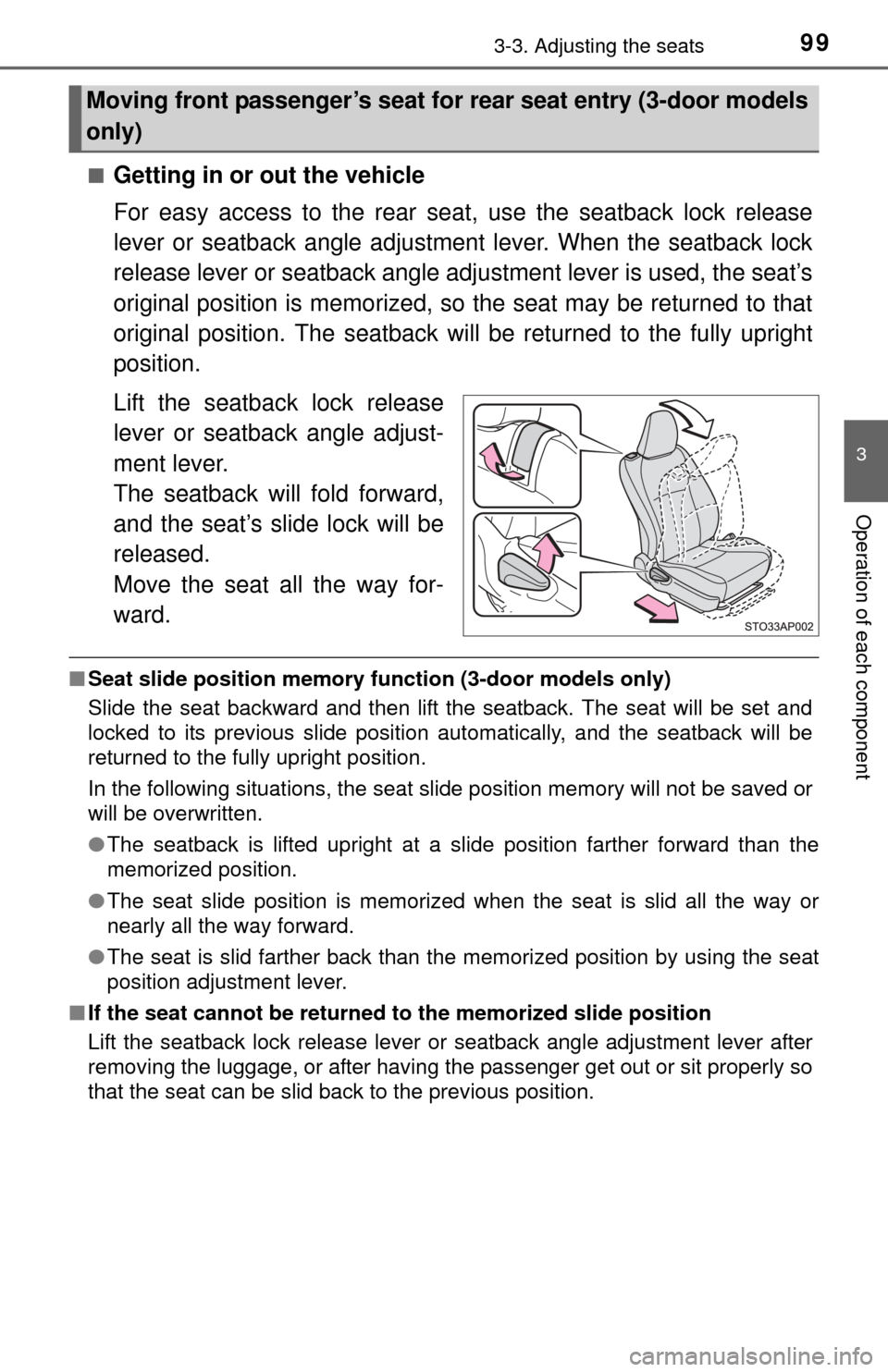
993-3. Adjusting the seats
3
Operation of each component
■Getting in or out the vehicle
For easy access to the rear seat, use the seatback lock release
lever or seatback angle adjustment lever. When the seatback lock
release lever or seatback angle adj ustment lever is used, the seat’s
original position is memorized, so the seat may be returned to that
original position. The seatback will be returned to the fully upright
position.
Lift the seatbac k lock release
lever or seatback angle adjust-
ment lever.
The seatback will fold forward,
and the seat’s slide lock will be
released.
Move the seat all the way for-
ward.
■ Seat slide position memory fu nction (3-door models only)
Slide the seat backward and then lift the seatback. The seat will be set and
locked to its previous slide position automatically, and the seatback will be
returned to the fully upright position.
In the following situations, the seat slide position memory will not be saved or
will be overwritten.
● The seatback is lifted upright at a slide position farther forward than the
memorized position.
● The seat slide position is memorized when the seat is slid all the way or
nearly all the way forward.
● The seat is slid farther back than the memorized position by using the seat
position adjustment lever.
■ If the seat cannot be returned to the memorized slide position
Lift the seatback lock release lever or seatback angle adjustment lever after
removing the luggage, or after having the passenger get out or sit properly so
that the seat can be slid back to the previous position.
Moving front passenger’s seat fo r rear seat entry (3-door models
only)
Page 100 of 364

1003-3. Adjusting the seats
WARNING
■When adjusting the seat position
● Take care when adjusting the seat position to ensure that other passen-
gers are not injured by the moving seat.
● Do not put your hands under the seat or near the moving parts to avoid
injury.
Fingers or hands may become jammed in the seat mechanism.
■ Seat adjustment
● Be careful that the seat does not hit passenger or luggage.
● To reduce the risk of sliding under the lap belt during a collision, do not
recline the seat more than necessary.
If the seat is too reclined, the lap belt may slide past the hips and apply
restraint forces directly to the abdomen, or your neck may contact the
shoulder belt, increasing the risk of death or serious injury in the event of
an accident.
Adjustments should not be made while driving as the seat may unexpect-
edly move and cause the driver to lose control of the vehicle.
● After adjusting the seat, make sure that the seat is locked in position.
● Never allow anyone to touch seatback lock release levers while the vehi-
cle is moving.
● If anyone is in the vicinity, make sure they are clear of the seat back path
and let them know that the seat is about to move.
■ After returning the seatback to the upright position
Make sure the seatback is securely locked by pushing it forward and rear-
ward. Failure to do so may result in death or serious injury.
NOTICE
■To prevent the seat lock mechanism malfunction
Do not use the seatback angle adjustment lever and seatback lock release
lever at the same time. If they are used together, the seat lock mechanism
may be damaged.